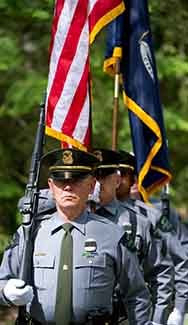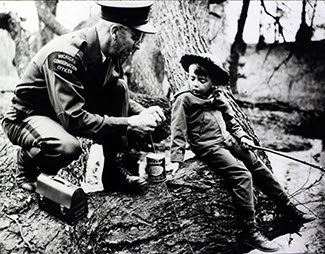Michigan: the expanding mission of conservation officers

The mission of the Michigan Department of Natural Resources’ Law Enforcement Division is to, “protect Michigan’s natural resources and the environment, and the health and safety of the public through effective law enforcement and education.”
It is a physically and mentally demanding career that officers and their families commit their lives to.
“Our mission evolves based on how our citizens and stakeholders engage in outdoor recreation,” said Steven Burton, assistant chief of the DNR’s Law Enforcement Division. “Our mission has been shifting for 133 years.”
Early conservation
State historical documents explain that the conservation movement began during a time when most people thought natural resources were in infinite supply.
Michigan citizens then realized there was a shortage of game, fish, timber and land due to human overexploitation and took it upon themselves to preserve what remained. As a result, citizens identified the need for natural resources regulation.
William Alden Smith was appointed the state’s first game warden in 1887, establishing the Law Enforcement Division. Smith was one of the first salaried wardens in the United States and began a tradition of excellence the division continues to adhere to today.
“As conservation officers, we ride on the coattails of those who came before us,” said Corporal Ivan Perez, a marine safety specialist with the DNR’s Law Enforcement Division. “We understand the prestige that comes with this specific type of law enforcement work. We try to uphold ourselves to that quality and level of respect in everything we do.”
Game wardens always have focused on the state’s natural resources and the people who utilize those resources. Given that, duties of officers have expanded over time.
“Our mission is to protect the natural resources and those who enjoy them,” Burton said. “Today, this includes search and rescue, marine, off-road vehicle, snowmobile, parks, forests, environmental protection – in general, all outdoor recreation and protection, in addition to duties inherent to law enforcement officers.”
Historical developments
In 1907, the game warden’s mission expanded from “game and fish” to “game, fish and forestry.”
In 1921, the Michigan Legislature created the Michigan Department of Conservation –the precursor to the Michigan DNR. That same year, the Conservation Commission, a citizen body appointed by the governor, was established to provide policy direction for department activities.
Throughout the following decades, the ranks of game wardens grew.
By 1924, there were 115 conservation officers in Michigan, who were paid $2.50 a day and each patrolled 841 square miles of land. There were more than 300 unpaid deputies who assisted.
Four years later, uniforms were issued to the 140 officers who then each patrolled just over 690 square miles of land, earning $5.50 per day. In 1931, a field administration section was formed to include wildland firefighting and law enforcement.
In 1932, due to the Great Depression, the division was reduced to about 120 officers. In 1933, radios with an AM-only signal were issued to officers to report forest fires.
Four years after that, the state’s 122 officers were issued department handguns for the first time. Previously, they had to provide their own firearms. In 1941, conservation officers received their first FM radios. In 1948, the division acquired two new commercial fishing patrol boats, uniforms and two planes.
With the Baby Boom after World War II, the 1960s signaled a new era in conservation as more demands were placed on natural resources by a growing population. In 1968, the Department of Conservation was renamed the Department of Natural Resources to address broader responsibilities.
“Shifting funding sources shifts priorities and creates new wildlife management methods,” Burton said. “In the past, revenue was generated from license sales and excise taxes. Now, it is shifting to funding models like the Recovering America’s Wildlife Act, timber sales, state land leasing (minerals, gas and oil), non-motorized use permits, camping or recreational fees, and sometimes, an increase in general fund budgets.”
As the department’s responsibilities expanded, so did the need to protect Michigan’s resources. This created an emphasis on building relationships with local user groups and concerned sportsmen and women who have similar goals.
During the 1970s, the number of conservation officers in the division rose from 162 to 202 who were each responsible for patrolling anywhere from 478 to 597 square miles.
“Our state’s population has boomed since those days,” Perez said. “What used to be corn fields are now subdivisions. It’s harder to establish a good rapport with people – we don’t have enough officers in the field to constantly know what’s going on in every single town like a small-agency officer may know. We will always rely on local relationships and for people to report complaints and tips.”
Today, the DNR is funded for 252 conservation officers – an all-time high.
“I’m proud of the excellent workforce we have today,” said Gary Hagler, chief of the DNR Law Enforcement Division. “We have sworn officers and civilian employees that are flexible and adaptable to the evolving nature of conservation law enforcement.”
Today’s roles and tradition
The current structure of the Law Enforcement Division includes at least two conservation officers assigned to patrol each of Michigan’s 83 counties. The officers are required to live in the counties they patrol. Sergeants and lieutenants oversee the day-to-day operations at the local level.
In addition, there are lieutenants, captains and executive and civilian staffers who manage operations at a regional and divisional level, and specialized units of conservation officers that include employment, training, legal and technology, recreational safety, education and enforcement, special investigations, Great Lakes enforcement and environmental investigations.
“When there was less population in an area, you knew a lot of people, and a lot of people knew you,” Perez said. “We used to knock on the door and do a lot of property visits. I still talk to the game warden who worked my spot prior to me because there’s always some wisdom he can share about a person, family or the county – there’s a lot of history there. There used to be more kids involved in the outdoors; technology didn’t keep them inside.”
Conservation officers utilize modern technology, but it can’t replace traditional face-to-face communication – a strong skill that future conservation officers must have.
“It’s up to the individual officers to reach out to people in their community to build relationships,” Perez said. “Often, when we contact families, parents will tell their child, ‘this is who protects the deer,’ but we also protect the rights and safety of the people who hunt the deer.”
Education goes together with communication, and conservation officers always have maintained a strong tradition of educating the public, particularly youth, about the natural resources.
“What has remained constant to every conservation officer in Michigan, old or new, is that we understand our responsibility to the youth of this state – to ensure they’re educated and understand the importance of our Great Lakes, forests, hunting and fishing,” Perez explains. “Hunting and fishing isn’t a right by law. I don’t know if people will still be hunting and fishing in 50 years, but I hope so. I’ll know that I did my part to help shape and encourage young minds to manage wildlife and enjoy the natural resources.”
Technology and training
Despite the learning curve that comes with modern technology, global positioning satellite (GPS) systems and digital documentation of evidence have their benefits for a conservation officer’s job.
“Technology has enhanced an officer’s ability to investigate a crime,” Perez said. “We can pull up a map to look at a piece of property to see who owns it and log daily reports from our patrol vehicles. It used to be you had a radio in your patrol vehicle that might be spotty at times. If you didn’t have that radio, you were literally on your own.”
The DNR’s 10th Conservation Officer Academy will begin in July. During the 23-week academy, recruits will be trained in state and national standards in general law enforcement, natural resource law and protection, survival skills and tactics, and equipment and technology.
Growing up hunting and fishing, Danny Walzak met several conservation officers and admired their commitment to enforcing laws and helping others. Today, Conservation Officer Walzak, who began his career in 1978, patrols Wayne County and has the most seniority in the DNR Law Enforcement Division.
“Everything a recruit goes through today was there in my academy – criminal contacts, search and seizure procedures – but it was in a reverse order,” Walzak said. “After attending orientation in Roscommon, I was sent home to begin training with field officers and then attended a regional police academy at Northern Michigan University in Marquette.”
Once the officer recruits in the upcoming academy graduate in December, they will receive a new Chevrolet Silverado patrol truck and spend about six months as probationary conservation officers working with field training officers throughout the state.
“We had basic equipment when I started as a conservation officer,” Walzak said. “My first patrol vehicle was a 1977 Plymouth Gran Fury, a common police vehicle at the time.”
During the probation period, new officers will gain hands-on experience and receive specialized training with snowmobiles, marine vessels and off-road vehicles.
“When I started, I had a 16-foot skiff,” Perez said. “Now, I patrol with a 25-foot Safe-boat with enough electronics to land you on the moon. We have the best boats and vehicles that can handle all terrains and transport.”
This equipment is essential to the work conservation officers do and helps save lives every year.
Serving in the U.S. Coast Guard, Perez was eventually stationed in Michigan to patrol the Great Lakes, where he met and worked with conservation officers. In 1995, Perez became a Michigan DNR conservation officer. He has spent most of his career as a conservation officer patrolling west Michigan’s Ottawa County.
Equipment and technology are vital for conservation officers, enabling them to be where they need to be, when they need to be there, to efficiently do their job.
“Conservation officers are a professional and reliable part of the fabric of law enforcement across the state,” Hagler said. “We not only protect the natural resources, but also the citizens and visitors that enjoy all of what Michigan has to offer.”
Perez says that the greatest perk of being a conservation officer today is having the ability to patrol areas as they see fit, according to various seasons and time of the year, to focus on the specific resource protection needs in each county.
“It’s always changing,” Perez said. “And that’s something that’s never changed.”
Visit Michigan.gov/ConservationOfficers to learn more about the DNR Law Enforcement Division and its conservation officers.
Check out previous Showcasing the DNR stories in our archive at Michigan.gov/DNRStories. To subscribe to upcoming Showcasing articles, sign up for free email delivery at Michigan.gov/DNR.






